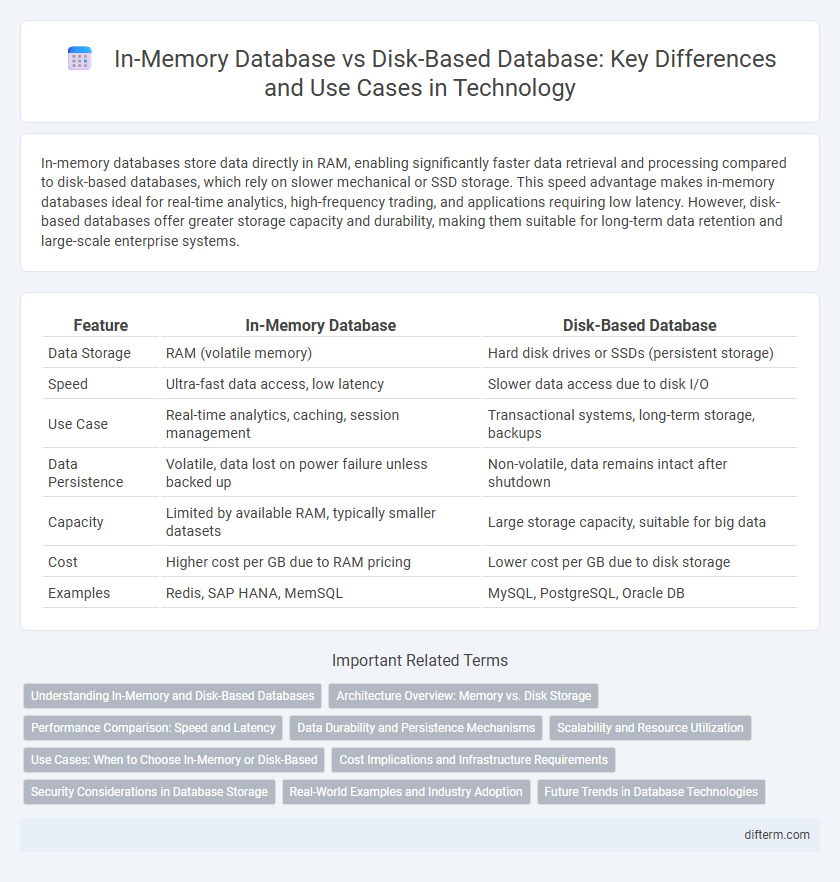In-memory databases store data directly in RAM, enabling significantly faster data retrieval and processing compared to disk-based databases, which rely on slower mechanical or SSD storage. This speed advantage makes in-memory databases ideal for real-time analytics, high-frequency trading, and applications requiring low latency. However, disk-based databases offer greater storage capacity and durability, making them suitable for long-term data retention and large-scale enterprise systems.
Table of Comparison
| Feature | In-Memory Database | Disk-Based Database |
|---|---|---|
| Data Storage | RAM (volatile memory) | Hard disk drives or SSDs (persistent storage) |
| Speed | Ultra-fast data access, low latency | Slower data access due to disk I/O |
| Use Case | Real-time analytics, caching, session management | Transactional systems, long-term storage, backups |
| Data Persistence | Volatile, data lost on power failure unless backed up | Non-volatile, data remains intact after shutdown |
| Capacity | Limited by available RAM, typically smaller datasets | Large storage capacity, suitable for big data |
| Cost | Higher cost per GB due to RAM pricing | Lower cost per GB due to disk storage |
| Examples | Redis, SAP HANA, MemSQL | MySQL, PostgreSQL, Oracle DB |
Understanding In-Memory and Disk-Based Databases
In-memory databases store data directly in RAM, enabling faster data access and real-time processing compared to disk-based databases, which rely on traditional hard drives or SSDs for storage. This fundamental difference results in significantly reduced latency and improved performance for applications requiring rapid data retrieval and updates. Disk-based databases offer greater storage capacity and durability, making them suitable for large-scale data persistence despite slower access speeds.
Architecture Overview: Memory vs. Disk Storage
In-memory databases leverage volatile RAM for data storage, providing ultra-fast read and write speeds compared to disk-based databases that rely on slower, persistent storage devices such as HDDs or SSDs. This architectural difference enables in-memory databases to minimize latency and maximize transaction throughput by eliminating the need for frequent disk I/O operations. Disk-based databases maintain durability and data persistence through complex caching and indexing mechanisms to optimize access times despite inherent storage limitations.
Performance Comparison: Speed and Latency
In-memory databases offer significantly faster data retrieval speeds and lower latency compared to disk-based databases due to storing data directly in RAM rather than on physical disks. This architecture reduces input/output bottlenecks and supports real-time analytics and high-frequency transaction processing. Disk-based databases, while more cost-effective for large volumes of data, inherently exhibit slower access times caused by mechanical read/write operations and increased latency.
Data Durability and Persistence Mechanisms
In-memory databases prioritize speed by storing data in RAM but rely on snapshotting or logging techniques to ensure data durability and persistence, making them vulnerable to data loss during power failures without proper backup. Disk-based databases inherently offer data durability by writing data directly to persistent storage, utilizing mechanisms like write-ahead logging and checkpoints to maintain data integrity and recovery. The choice between these databases impacts durability guarantees, with in-memory solutions requiring robust persistence strategies to match the reliability of disk-based systems.
Scalability and Resource Utilization
In-memory databases provide superior scalability by enabling rapid data access and real-time processing through RAM storage, significantly reducing latency compared to disk-based databases. Disk-based databases rely on slower I/O operations, limiting scalability as data volumes grow and increasing resource consumption on storage hardware. Efficient resource utilization in in-memory systems optimizes CPU and memory use, whereas disk-based systems often incur overhead from frequent disk read/write cycles and cache management.
Use Cases: When to Choose In-Memory or Disk-Based
In-memory databases excel in real-time analytics, high-frequency trading, and caching scenarios where ultra-low latency and rapid data processing are critical. Disk-based databases are preferred for applications requiring large-scale data storage, such as archival systems, traditional ERP, and systems with complex transactional consistency. Choosing between in-memory and disk-based solutions depends on balancing performance needs with data volume and durability requirements.
Cost Implications and Infrastructure Requirements
In-memory databases demand higher upfront investment due to the need for extensive RAM, significantly increasing hardware costs compared to disk-based databases that rely on more affordable storage drives. Disk-based systems typically incur lower infrastructure expenses but may require additional maintenance and slower performance can lead to indirect operational costs. Enterprises must weigh the total cost of ownership, balancing the premium for speed and real-time analytics in-memory solutions provide against the scalability and budget-friendliness of disk-based architectures.
Security Considerations in Database Storage
In-memory databases store data directly in RAM, offering faster access but requiring robust encryption and physical security measures to prevent data breaches due to volatility and potential memory dumps. Disk-based databases leverage persistent storage with built-in encryption at rest and advanced access controls, minimizing the risk of data loss but potentially facing higher latency during encryption processes. Security strategies must balance speed and protection by implementing multi-layered authentication and regular auditing tailored to the specific storage architecture.
Real-World Examples and Industry Adoption
In-memory databases like SAP HANA and Redis deliver ultra-fast data processing by storing data directly in RAM, enabling real-time analytics for industries such as finance and telecommunications. Disk-based databases like Oracle Database and MySQL remain widespread in sectors requiring reliable, large-scale data storage with strong consistency, including government and healthcare. Enterprises adopt hybrid approaches combining in-memory speed and disk-based persistence to optimize performance and durability in complex applications.
Future Trends in Database Technologies
In-memory databases are poised to dominate future database technologies due to their ultra-low latency and real-time processing capabilities, leveraging advances in RAM speed and capacity. Emerging hybrid models combine in-memory speed with disk-based durability, ensuring data consistency and scalability across cloud environments. The integration of AI-driven optimization and edge computing further accelerates the shift toward intelligent, distributed database solutions tailored for next-generation IoT and big data analytics.
in-memory database vs disk-based database Infographic

 difterm.com
difterm.com